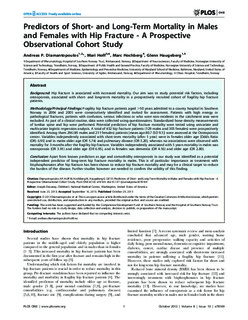| dc.contributor.author | Diamantopoulos, Andreas P | |
| dc.contributor.author | Hoff, Mari | |
| dc.contributor.author | Hochberg, Marc C. | |
| dc.contributor.author | Haugeberg, Glenn | |
| dc.date.accessioned | 2015-11-20T11:13:11Z | |
| dc.date.accessioned | 2016-05-24T09:21:01Z | |
| dc.date.available | 2015-11-20T11:13:11Z | |
| dc.date.available | 2016-05-24T09:21:01Z | |
| dc.date.issued | 2013-10-29 | |
| dc.identifier.citation | PLoS ONE 2013, 8(10:e78169) | nb_NO |
| dc.identifier.issn | 1932-6203 | |
| dc.identifier.uri | http://hdl.handle.net/11250/2390147 | |
| dc.description.abstract | Background: Hip fracture is associated with increased mortality. Our aim was to study potential risk factors, including
osteoporosis, associated with short- and long-term mortality in a prospectively recruited cohort of fragility hip fracture
patients.
Methodology/Principal Findings: Fragility hip fracture patients aged .50 years admitted to a county hospital in Southern
Norway in 2004 and 2005 were consecutively identified and invited for assessment. Patients with high energy or
pathological fractures, patients with confusion, serious infections or who were non-residents in the catchment area were
excluded. As part of a clinical routine, data were collected using questionnaires. Standardized bone density measurements
of lumbar spine and hip were performed. Potential predictors of hip fracture mortality were tested using univariate and
multivariate logistic regression analysis. A total of 432 hip fracture patients (129 males and 303 females) were prospectively
identified. Among them 296 (85 males and 211 females) patients [mean age 80.7 (SD 9.1)] were assessed at the Osteoporosis
center. Variables independently associated with short-term mortality (after 1 year) were in females older age [Odds Ratio
(OR) 6.95] and in males older age (OR 5.74) and pulmonary disease (OR 3.20), whereas no associations were observed with
mortality for 3 months after the fragility hip fracture. Variables independently associated with 5 years mortality in males was
osteoporosis (OR 3.91) and older age (OR 6.95), and in females was dementia (OR 4.16) and older age (OR 2.80).
Conclusion: Apart from known predictors as age and comorbidity osteoporosis in our study was identified as a potential
independent predictor of long-term hip fracture mortality in males. This is of particular importance as treatment with
bisphosphonates after hip fracture has been shown to reduce hip fracture mortality and may be a clinical target to reduce
the burden of the disease. Further studies however are needed to confirm the validity of this finding. | nb_NO |
| dc.language.iso | eng | nb_NO |
| dc.publisher | Public Library of Science | nb_NO |
| dc.rights | Navngivelse 3.0 Norge | * |
| dc.rights.uri | http://creativecommons.org/licenses/by/3.0/no/ | * |
| dc.title | Predictors of short- and long-term mortality in males and females with hip fracture - A prospective observational cohort study | nb_NO |
| dc.type | Journal article | nb_NO |
| dc.type | Peer reviewed | nb_NO |
| dc.date.updated | 2015-11-20T11:13:11Z | |
| dc.source.volume | 8 | nb_NO |
| dc.source.journal | PLoS ONE | nb_NO |
| dc.identifier.doi | 10.1371/journal.pone.0078169 | |
| dc.identifier.cristin | 1077950 | |
| dc.description.localcode | © 2013 Diamantopoulos et al. This is an open-access article distributed under the terms of the Creative Commons Attribution License, which permits unrestricted use, distribution, and reproduction in any medium, provided the original author and source are credited. | nb_NO |

